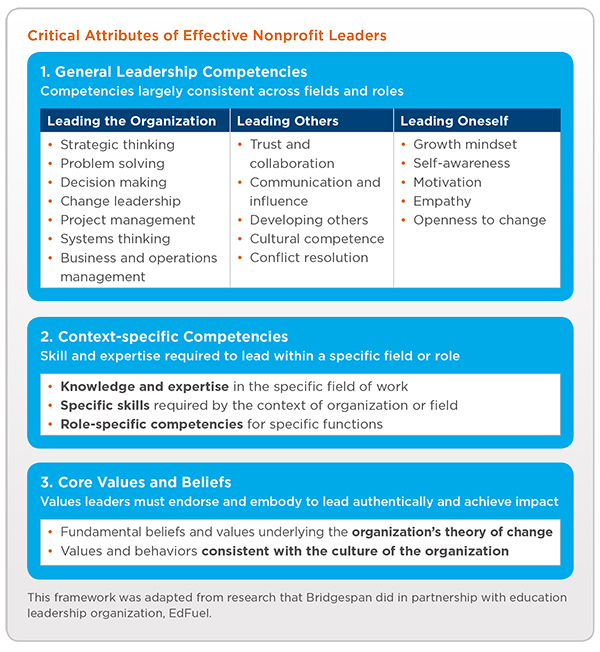There are a lot of perspectives on leadership from the for-profit and nonprofit worlds. A quick search on Amazon alone surfaces over 30,000 books on the topic, with more being released each week. Among these are thousands dedicated to nonprofit leadership and management.
It's not surprising that so much attention is paid to good leadership. Understanding what skills and competencies an organization needs guides its talent strategy, from hiring decisions to leadership development to effectively assessing success in a given role. But often, nonprofits are too focused on those that are job-related, and forget that there are a whole host of competencies leaders need to succeed.
In an effort to cut through the clutter of literature and research, and to help nonprofits better understand what makes for an effective nonprofit leader, we partnered with The David and Lucile Packard Foundation to conduct a review of select existing research and writing on the topic (see our bibliography of selected sources). Bridgespan reviewed a wide variety of sources from the nonprofit and private sectors to better understand current thinking on the key attributes needed for effective leadership, including:
- Published research from sources such as Harvard Business Review, McKinsey, The Bridgespan Group, and The Center for Creative Leadership's Handbook of Leadership Development
- Leadership frameworks and competency models currently in use by a range of nonprofit and for-profit organizations
- Two surveys of hundreds of nonprofit leaders about the key attributes required to succeed in senior management roles1
What we found was that there is no consensus answer to what makes a great nonprofit leader. Different sources use different language and labels to describe the competencies required for leaders to be successful. However, many of the sources we reviewed agree on three key categories that provide a starting framework for thinking about the attributes that make a great leader.
The first category of competencies are General Leadership Competencies. These are the basic qualities of an effective leader that tend to be consistent across fields and roles. While leadership experts differ in how they talk about these qualities, they largely fall into three buckets: leading the organization, leading others, and leading oneself. The relative importance of these buckets and their contents might vary by the needs and context of the organization, but a successful leader will likely have strong qualities across all three.
The second category, Context-Specific Competencies, are the skills and expertise leaders need in order to lead within a specific field or role. Many believe these are the most critical attributes: In a Bridgespan survey of over 400 nonprofit leaders, context-specific experience was the most commonly mentioned attribute for what senior managers need to achieve organizational outcomes.2 Our research uncovered three types of field-specific, or functional, competencies that are important:
- Knowledge and expertise in the specific field of work: For instance, a leader working for a juvenile justice organization may be more successful if they understand and have connections to the juvenile justice system they are seeking to influence. Similarly, to be successful leading an organization focused on ending climate change, one will need to understand the science and politics behind the issue.
- Specific skills demanded by the context of the field or organization: A leader in the reproductive health field will likely need to be skilled in advocacy while an organization that has been consistently struggling will need a leader with expertise in turnarounds.
- Role-specific competencies: These are the technical skills leaders need in order to perform their functional roles. For instance, a chief development officer should have expertise in fundraising while a chief financial officer will need an accounting and financial management background.
The final category important for being an effective nonprofit leader is Core Values and Beliefs. Two dimensions emerged from our research:
- Fundamental beliefs and values consistent with the organization's theory of change: For instance, a leader of a progressive education reform organization will need to fundamentally believe and demonstrate a commitment to the idea that all students can achieve.
- Values and behaviors consistent with the culture of the organization: A great nonprofit leader needs to endorse and embody the fundamental values of the people they lead. For instance, an organization seeking to promote diversity and inclusion will need a leader who is committed to and prioritizes racial equity.
What's clear from our research is that what makes a great leader heavily depends on the context in which the individual leads. There is no one-size-fits all definition. Nonprofits and field leaders should develop definitions of great leadership tailored to their needs—based on the issues, priorities, values, and context in which they work. This framework provides a solid starting point for developing those definitions as well as the talent strategies and processes organizations need to meeting their goals today and in the future.
Libbie Landles-Cobb is a manager in The Bridgespan Group's San Francisco office. Leah Karlins, formerly a consultant with Bridgespan, is currently an MBA student at Yale School of Management.
Download a PDF of this articleFootnotes
1. These included a 2014 Bridgespan survey of 438 senior leaders from across the nonprofit sector and a 2013 McKinsey study of 196 US-based senior leaders at nonprofits, foundations, and social enterprises.
2. In January 2015, Bridgespan surveyed 438 nonprofit senior leaders on their ability to recruit, develop, and retain senior managers. As part of this we asked, "What are the three most critical attributes that you anticipate senior managers will need over the next two years in order to achieve the outcomes your organization seeks?"
Bibliography
"Blueprint for Success Leadership Competency Map," Edfuel, May 2015.
Callanan, Laura, Nora Gardner, Lenny Mendonca, and Doug Scott, "What social-sector leaders need to succeed," McKinsey Insights, November 2014.
Callanan, Laura, Nora Silver, and Paul Jansen, "Leveraging Social Sector Leadership," UC Berkeley Haas School of Business, 2015.
Collins, Jim, "Level 5 Leadership: The Triumph of Humility and Fierce Resolve," Harvard Business Review, July 2005.
"Developing Strong Leaders," The YMCA, 2013.
Feser, Claudio, Fernanda Mayol, and Ramesh Srinivasan, "Decoding leadership: What really matters," McKinsey Quarterly, January 2015.
Goleman, Daniel, "What Makes a Leader?" Harvard Business Review, January 2004.
Horwitch, Mark and Meredith Whipple, "Leaders who inspire: A 21st-century approach to developing your talent," Bain Insights, June 11, 2014.
"KIPP Leadership Competency Model," KIPP Foundation.
"Leadership Development & Performance Management," Johnson & Johnson.
"Leadership Program Outcomes," Leadership Learning Community, April 16, 2001.
"Map the Gap: Confronting the Leadership Talent Gap in the New Urban Education Ecosystem," Edfuel, April 29, 2014.
McCauley, Cynthia D., Ellen Van Velsor, and Marian N. Ruderman, "Introduction: Our View of Leadership Development," The Center for Creative Leadership Handbook of Leadership Development: Third Edition, ed. Ellen Van Velsor (San Francisco: Jossey-Bass, 2010), 1-26.
"Nonprofit Sector Leadership Pipelines Research," General Survey Findings Overview: The Bridgespan Group, 2015.
Petrie, Nick, "Future Trends in Leadership Development," Center for Creative Leadership, 2014.
"The Skills the Nonprofit Sector Requires of its Managers and Leaders," Nonprofit Leadership Alliance, June 2011.
"When to change how you lead," McKinsey Quarterly, June 2015.
Yip, Jeffrey and Meena Wilson, "Leadership Development Systems," The Center for Creative Leadership Handbook of Leadership Development: Third Edition, ed. Ellen Van Velsor (San Francisco: Jossey-Bass, 2010).




